Birthplace, House History

Beez Neez now Chy Whella
Big Bear and Pepe Millard
Fri 29 Jun 2018 22:37
|
Shakespeare’s Birthplace – the House Through the
Ages 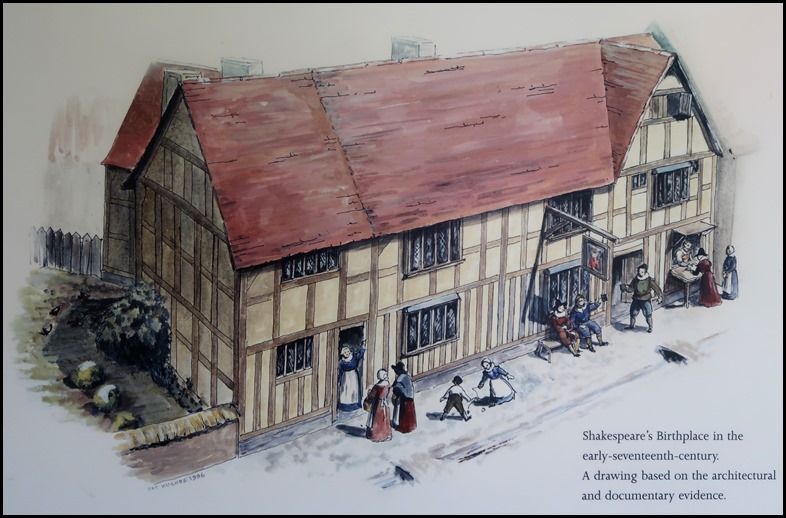 Shakespeare’s Birthplace.
The Changing Face of the
Birthplace. Like most of Stratford’s sixteenth-century houses the Birthplace was
built from local materials, using oak from the nearby Forest of Arden for the
timber frame and stone from a quarry at Wilmcote, three miles from the town, for
the foundation walls, chimneys and some of the floors. Despite alterations and
restoration work over the centuries, much of the original structure of the house
survives.
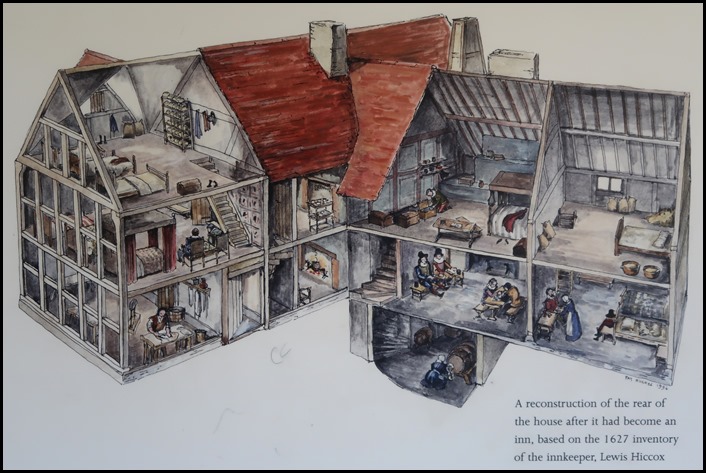 An incredible
insight from this reconstruction of
1627.
 The arrow on the top left points to
The Rear Wing. This part was added to the
building, probably in the early-seventeenth-century when the house became an
inn. It is likely that the main room with a drinking parlour: beneath it a
cellar still survives.
The arrow on the top
right points to The Main House. The design of the house where Shakespeare grew
up followed a traditional plan. On the ground floor was a parlour and adjoining
central hall separated from a service/workshop area by a cross-passage. Above
were bedchambers and probably attic rooms.
It is likely there was a separate
kitchen and brewhouse at the back of the house, with other outbuildings and
workshop areas used by Shakespeare’s father, who was a glove-maker and wool
dealer.
The arrow on the bottom left points to
Joan Hart’s Cottage. This small dwelling,
(where we stood to take this picture) was occupied by Shakespeare’s
sister, Joan Hart, and her family during the first part of the
seventeenth-century. It was constructed several years after the main house and
was originally a separate building.
The property remained in the ownership
of Shakespeare’s direct descendants until 1670, when his granddaughter,
Elizabeth Barnard, died. As she had no children, Elizabeth left the estate to
her relative, Thomas Hart, Shakespeare’s great-nephew.
The main house became a tenanted inn
called the Maidenhead (later the Swan and Maidenhead)
following the death of John Shakespeare in 1601. Members of the Hart family
continued living in the small adjoining cottage throughout the century. The two
earliest inventories of the house, dated 1627 and 1648, reveal in detail in
which rooms were used and furnished.
The eighteenth-century saw the
continued family ownership of the property by the Harts, descendants of
Shakespeare’s sister, Joan.
At the beginning of the century,
Shakespeare Hart (Joan Hart’s great grandson), divided the main house. The
Swan and Maidenhead Inn now occupied only the eastern two-thirds of the
building, while members of the Hart family lived in the remaining portion of the
main house until 1793.
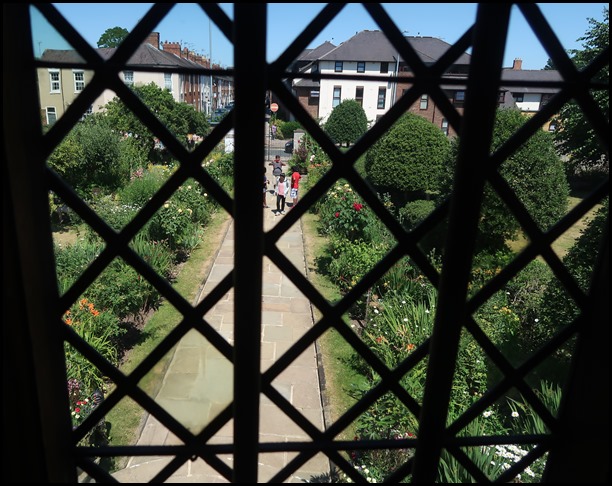 The Swan and
Maidenhead Inn. “Return and sleep within mine inn; for with long travel I am
stiff and weary.” The Comedy of Errors. 1.2.13-14. Shakespeare
inherited the entire house from his father in 1602, at the age of 37.
Shakespeare already owned the sizeable property New Place so did not need to
live in the house, and instead turned his eye to moneymaking. This part of the
house was leased to Lewis Hiccox who extended it as an inn, later called
‘The Swan and Maidenhead’.
The inn provided weary travellers with
a place to sleep and we believe that at one time it included thirteen rooms,
most of them with wooden bedsteads. However, if you were on a budget a simple
straw mattress and a log for a pillow would have provided your bed for the
night.
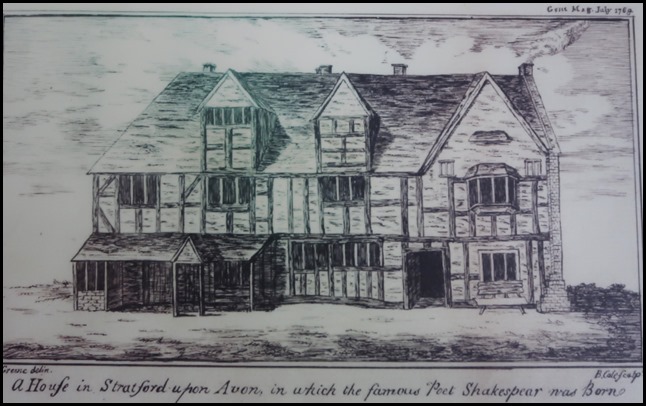 1769. The
earliest illustration of the Birthplace, by Richard Greens, shows the building
with windows set into the roof, a gable and a porch. Although the picture
depicts the house standing on its own, it was in fact one of a continuous row of
properties along Henley Street.
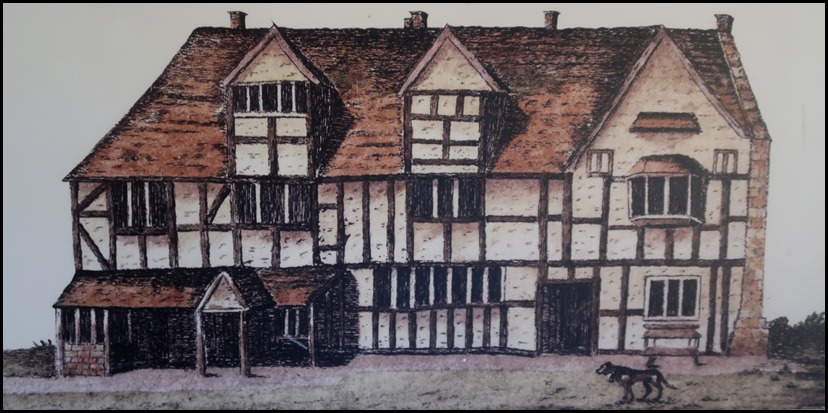 An engraving of the Birthplace dated 1788 by Philip de la
Motte.
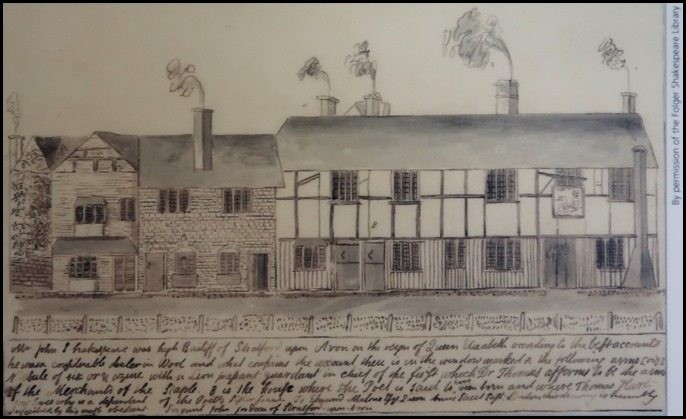 1790. A
drawing by John Jordan shows that by the late eighteenth century the roof
windows and gable end had been removed.
 A pen and ink drawing by Samuel Ireland
of the Birthplace kitchen in the late
eighteenth-century.
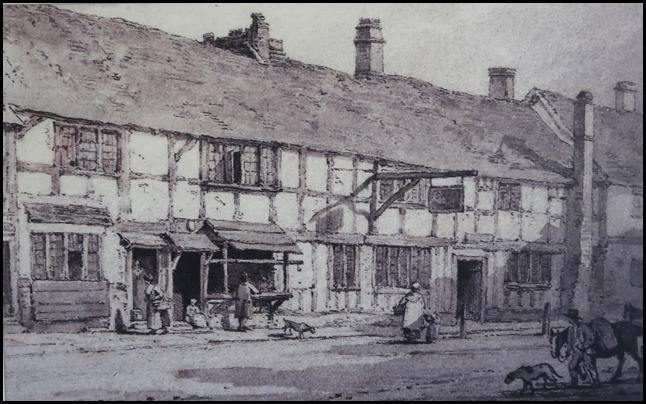 1807. This
drawing by Henry Edridge illustrates the western portion of the main house in
use as a butcher’s shop. The eastern part was still functioning as an inn, the
Swan and Maidenhead.
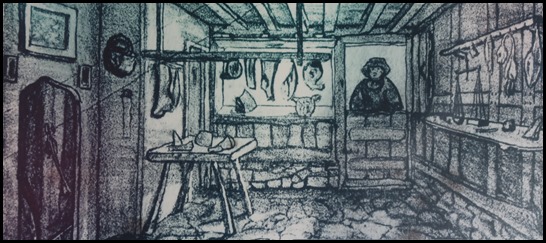 Inside the
butcher’s shop in 1823. During
the late eighteenth and early nineteenth-centuries the western portion of the
main house was let to Thomas Hornby, a butcher, and his wife Mary, who acted as
self-appointed custodians of the Birthplace.
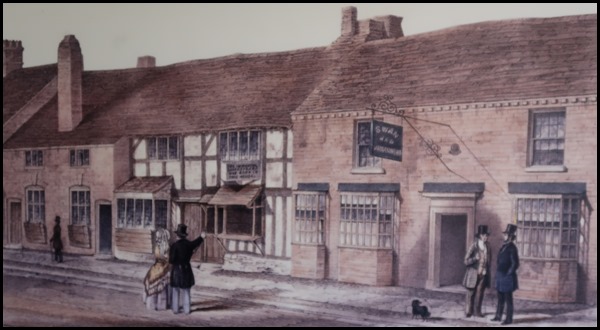 c.1835. By the 1830‘s the frontage of
the Swan and Maidenhead Inn had acquired a
fashionable, brick facade.
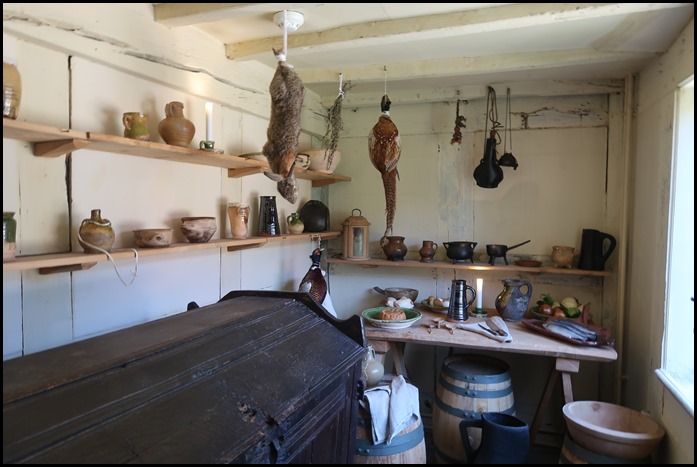 The Drinking
Parlour. ‘Good company, good wine, good welcome can make good
people. Henry VIII 1.4.6-7. Ale was readily available here in the drinking
parlour, along with a small selection of wine, and hot and cold food from the
buttery. Tudor inns were loud and busy but there were punishments for drunken
behaviour, including having to wear a ‘drunkard’s cloak’ (a hollowed out beer
barrel) around the town.
In Tudor England, drinking ale was
safer than drinking water. Shakespeare’s father had previously acted as ‘ale
taster’ for Stratford, but even normal adults could drink as much as 17 pints of
ale a week.
The inn did not close until 1846, by
which time this house was well established as a destination for literary
pilgrims hoping to learn more about Shakespeare. After visiting the birthroom
they could come downstairs and enjoy a drink!
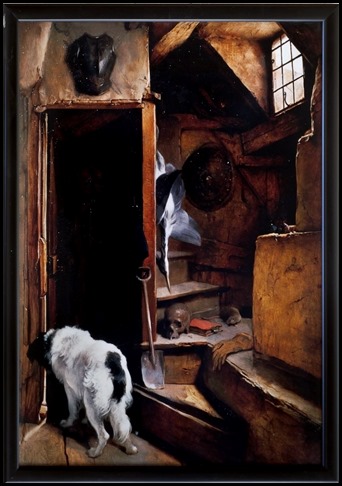 ‘In Shakespeare’s House, Stratford-upon-Avon’ by Henry
Wallis (1830-1916) and Edwin Landseer (1803-1873). We saw this copy hanging on
the wall during our visit, the original is in the V&A Picture
Library.
 The room above Shakespeare’s fathers glove
workshop held the Birthroom Window and some display
cases.
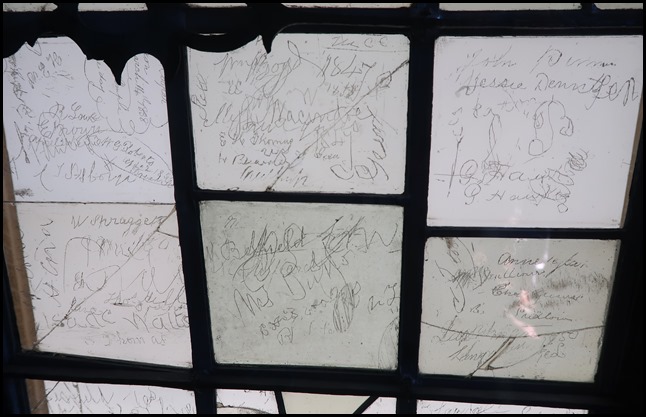 The Birthroom Window. This window was
formerly in the birthroom of Shakespeare’s Birthplace. It became traditional for
pilgrims to etch their names into the glass as a symbol of their visit. The
earliest recorded date on the window is 1806.
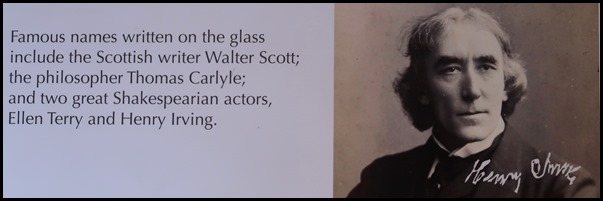 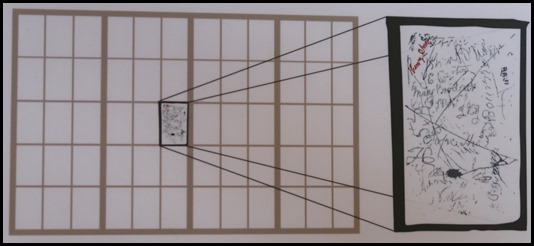   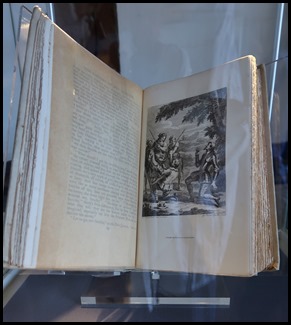 Literary Contemporaries. Tang Xianzu. 1550 – 1616. Tang was a Chinese playwright who
created works that were both popular and influential during his own lifetime and
beyond. Tang’s great work Peony Pavilion, written in 1598, is often
compared to Shakespeare’s Romeo and Juliet. It is a story of a
young woman who dies for love, pining for a man she met in a dream. After the
man falls in love with her portrait, she is brought back to life. Any similarity
between the work of Tang and Shakespeare is coincidental as England had very little contact
with China in the early 1600s.
Miguel de
Cervantes. 1547 – 1616. Spanish writer Cervantes’ most famous work was
The Ingenious Gentleman Don Quixote of la Mancha, published in 1605.
Cervantes’ wit and use of wordplay was similar to Shakespeare’s and his work also inspired new phrases. One example is tilting
at windmills, referring to pursuing the impossible. Shakespeare may have read Cervantes’ work
and even been influenced by him. Cervantes published the second part of Don
Quixote in 1615.
Cervantes, Tang Xianzu and
Shakespeare all died the
following year.
 Early Pilgrims. In
1769, David Garrick, the greatest actor of his time, staged the Shakespeare
Jubilee in Stratford-upon-Avon. This was the world’s first Shakespeare Festival
and it was attended by hundreds of people. Garrick’s Jubilee put Stratford on
the map as a place of pilgrimage, with Shakespeare’s Birthplace at the heart of
it.
1 Glass
Jug. 1600s. Actor, manager and playwright, David Garrick sipped wine from
this jug at the Shakespeare Jubilee in 1769. At that time it was owned by the
town clerk, William Hunt. According to tradition one of the previous owners of
the jug was William Shakespeare.
2. Ceramic Salt
Cellar. 1735 – 1769. This salt cellar is believed to have been used
during the Shakespeare Jubilee of 1769. It was made in China.
3 Three wax
impressions made by David Garrick’s personal seal.
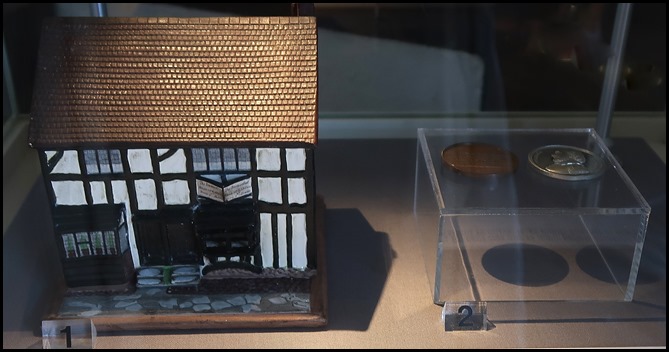 In 1838 Charles Dickens visited Shakespeare’s Birthplace.
In 1847 when the house went up for sale by its last private owner, Dickens was
one of many people involved in a successful campaign to purchase the building
for the nation, saving it for future generations to enjoy. Huge public interest
in the sale led to the development of all sorts of ‘spin off’
items.
1. Ceramic
Nightlight or Cigar Rest. 1847. Shakespeare’s Birthplace was sold at public
auction on 16 September 1847. The design for this Birthplace shaped nightlight
or cigar holder was registered by Egerton Jacobson Filmore on 21 September, five
days later. Cigar smoke would have escaped through the
chimney.
2. Two
Medals struck to commemorate the sale of Shakespeare’s Birthplace. 1847. Each is
decorated with a portrait of Shakespeare on one side and an image of the Birthplace on the
other. Engraved by Allen and
Moore.
ALL IN ALL A FASCINATING LOOK AT
THE PROPERTY HISTORY
NEW KNOWLEDGE, SO
INTERESTING |